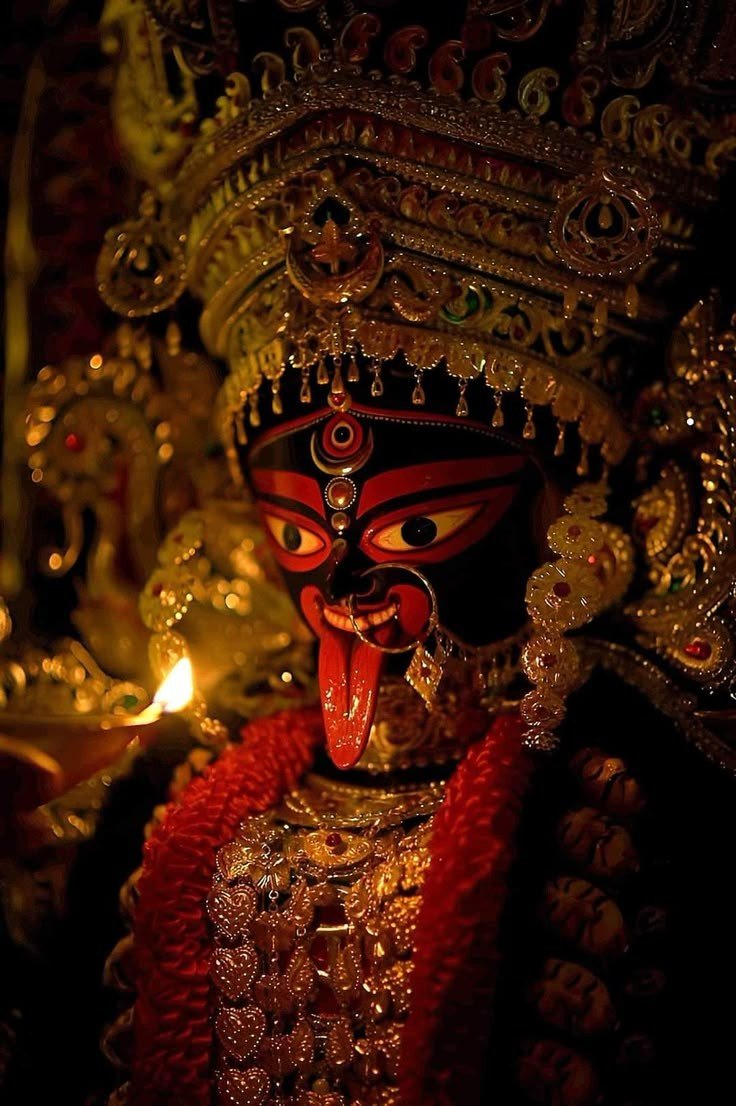Day 7 of Navratri: Kaal Ratri – The Night of Power and Transformation

Navratri, the nine-night festival dedicated to the worship of Goddess Durga, is a time of celebration, reflection, and spiritual growth. Each day of this festival highlights a different aspect of the Divine Feminine, symbolizing various energies, powers, and virtues that the Goddess embodies. On the seventh day of Navratri, we encounter **Kaal Ratri**, the most intense and transformative day of the festival. Kaal Ratri, meaning “The Night of Time,” is dedicated to the fierce form of Goddess Durga, often depicted with a dark complexion and riding a donkey. This day signifies the destruction of evil and the ultimate triumph of good over darkness.
### The Symbolism of Kaal Ratri
Kaal Ratri is one of the most powerful and awe-inspiring forms of Goddess Durga. Her dark form represents the transformative power of time and the annihilation of negativity. The word "Kaal" refers to both "time" and "death," making this form of Durga the embodiment of destruction — a force that wipes out all that is harmful or obstructing progress.
In this form, Goddess Durga is depicted with a terrifying and powerful appearance: she has disheveled hair, a dark complexion, and often rides a donkey. She holds a sword, and her eyes blaze with intensity. While she may appear fearsome, her power is not to be feared but embraced. Her energy is one that purges all fear, ego, and obstacles in our lives, allowing for a fresh start or a renewal of purpose.
### The Spiritual Significance
Kaal Ratri is a time to look within and confront the darkness that resides in our own hearts and minds. It is a day dedicated to deep introspection and self-purification. The Goddess’s fierce energy challenges us to let go of the attachments and patterns that no longer serve us, and it encourages us to face our fears head-on.
It is said that the Goddess, in her Kaal Ratri form, represents the power to annihilate not just external evil but also the darkness within — our ignorance, our negative thoughts, and our doubts. She empowers us to overcome obstacles and find the courage to face challenges in life.
This day marks a turning point in the festival, where we are asked to release anything that is limiting our growth, whether it's an unhealthy habit, toxic relationship, or unresolved emotions. By surrendering to Kaal Ratri’s transformative power, we are preparing ourselves for the triumph of light on the final day of Navratri.
### Rituals and Prayers on Kaal Ratri
On this day, devotees typically observe a night of fasting and prayer, staying awake to engage in spiritual practices. The night vigil is symbolic of staying alert and focused on one’s spiritual goals. It’s an opportunity to reflect on personal struggles and seek the Goddess’s guidance to overcome them. Chanting mantras and reciting hymns, particularly those dedicated to Goddess Durga, is common.
One of the most prominent mantras associated with Kaal Ratri is:
*"Om Hreem Kaal Raatri Namah"*
This chant helps invoke the Goddess's protection and strength. In some traditions, devotees also perform the **Durga Saptashati**, a scripture that describes the Goddess’s various forms and her victory over evil forces. Offering flowers, lighting diyas (lamps), and keeping the surroundings clean and sacred are all part of the rituals on this powerful night.
### The Role of Kaal Ratri in the Nine-Night Journey
Kaal Ratri plays a pivotal role in the journey of self-discovery that Navratri symbolizes. The first few days of the festival are about invoking and connecting with the Goddess’s gentler aspects, focusing on purity, peace, and wisdom. By Day 7, the energy shifts to a more intense and transformative stage. The fierce form of Kaal Ratri signifies the purging and release of old energies to make space for new, positive growth.
The days leading up to Kaal Ratri are about nurturing the inner self, while the last phase of Navratri — symbolized by Kaal Ratri — is a call to cleanse and purify. The destruction represented by the Goddess on this day paves the way for the creation of new possibilities, and it invites us to shed any negativity, doubts, or fears that may have accumulated over time.
### Conclusion: Embracing Change
Kaal Ratri is a reminder that to experience personal and spiritual growth, we must be willing to let go of what no longer serves us, even if it is painful or difficult. It is about facing our inner shadows, fears, and uncertainties and allowing the power of transformation to take over. As we enter the last few days of Navratri, Kaal Ratri prepares us for the ultimate victory of light, peace, and harmony — the triumph of Goddess Durga over the forces of darkness.
This day of Navratri, let the energy of Kaal Ratri help you confront your fears, cleanse your inner self, and prepare for the blessings that await you. The destruction she brings is not an end but a beginning — a chance to transform and rise stronger.
